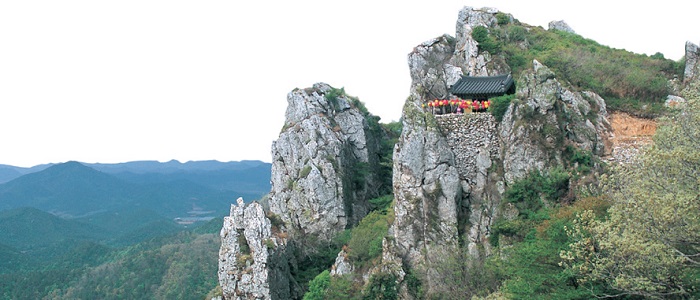Land’s end: Haenam
If you’re looking to escape the urban jungle of Seoul for a weekend, it would be hard to find a spot further away than Haenam. Jutting out into the southern seas at the very southwest tip of the Korean Peninsula, not only is Haenam far away geographically, but in terms of ambiance, the bucolic landscape of mountains, fields and coastlines is worlds away from the rat race. The hills are home to some of the country’s most spectacular Buddhist temples, while the region’s islands are treasure troves of scenic beauty and cultural enrichment. Mix in some of Korea’s best regional cuisine, and you have all the makings of a great weekend away from the city.

Dosoram Hermitage, Mt. Dalmasan © Haenam County Hall
Gosan historical relics
Just outside of Haenam’s very provincial downtown is the village of Yeondong-ri, a collection of historic Korean houses that was the home of famed 17th-century poet and scholar “Gosan” Yun Seon-do. Here you’ll find a museum with examples of works by Gosan and his descendants, a number of shrines, and the ancestral home of the Haenam Yun clan.
Daeheungsa Temple
Hidden deep within the ancient forests of Mt. Duryunsan is the important Buddhist monastery of Daeheungsa Temple. The temple was founded in either the fifth or sixth century, and has been rebuilt numerous times since then. During the Japanese invasion of 1592, the renowned warrior monk Seosan used the temple as the headquarters for his monk army as they fought against the invaders. The temple has also produced a good many famous monks, including the Zen master Choui, who led the revival of the Korean tea ceremony in the late Joseon era.
The monastery itself is quite large and can be reached via a very nice walk or shuttle bus ride through some of Korea’s oldest forests. The temple is home to many historic buildings, including the beautiful main hall with its fantastically crooked wooden pillars. The main courtyard is off to the left, separated from the rest of the complex by a beautiful stream. There is also a Confucian shrine dedicated to Seosan behind the temple.

Old homes at Yeondong-ri (left) and a thousand Buddhas at Daeheungsa Temple © Haenam County Hall
Mihwangsa Temple
About 30 minutes south of Daeheungsa on the road to Ttangkkeut Maeul is another Buddhist temple, Mihwangsa. Mihwangsa isn’t a big temple, but it makes up for its size with a stunning backdrop, the craggy peaks of Mt. Dalmasan. Named for Bodhidharma, an Indian monk who transmitted the Zen tradition to East Asia, the mountain beautifies the temple like a silk folding screen.
The temple offers views of the sea from its higher points. The main prayer hall has been designated National Treasure No. 947, and is noted for its intricate interior artwork. Mt. Dalmasan is a recommended climb, but be warned: It is a rugged peak and is not an easy hike. The Buddhist hermitage of Dosoram, perched on a cliff, offers awe-inspiring views of the surrounding summits.
Ttangkkeut Maeul
Once a small backwater fishing village, Ttangkkeut Maeul (Land’s End Village) has in recent years become a major tourist destination owing to its location at the very southwesternmost point of the Korean Peninsula. Here, you’ll find a number of motels, seafood restaurants and shops selling the village’s famous seaweed, as well as the ferry to the scenic island of Bogildo.
The best views can be had from the observation platform atop a hill overlooking the harbor. Be sure to take in the sunset. There’s a monorail to the observatory if you don’t want to hike it.
Bogildo Island
Part of Dadohae Maritime National Park, Bogildo has its natural charms, including the beautiful Yesong-ri Beach, a 1-kilometer crescent of blue-pebble beach wedged between a mountain and the sea.
A must-see in Bogildo is the Yun Seon-do Historical Site, one of the most beautiful examples of Korean traditional gardening in the country. In 1637, after King Injo (r. 1623-1649) surrendered to the invading Manchus, Yun fled to Jejudo Island out of despair. Along the way, his boat ran into a typhoon, so he stopped at Bogildo Island to let the storm pass. He liked what he saw, however, and rather than continue on to Jejudo, he decided to stay. He built a home and a garden and put pen to paper, penning his greatest poetry.
The Seyeonjeong Garden, the best-known part of the historical site, exemplifies the beauty of the Korean garden. The landscape is left as naturallooking as possible, with enhancements here and there for greater visual impact. It is as enchanting today as it was in Yun’s time.
- Article from Korea Magazine (December 2014)
